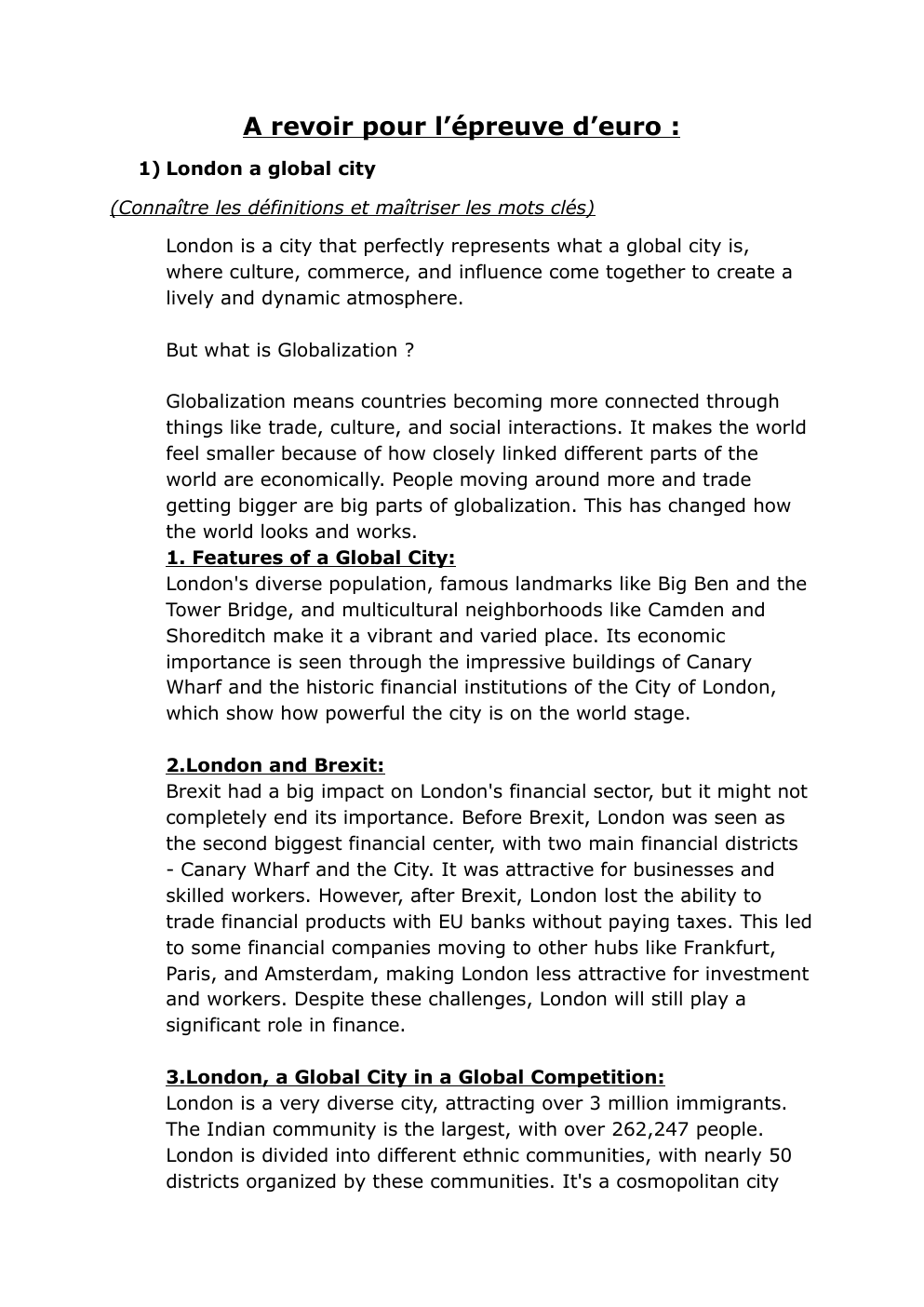Londres pendant la Seconde guerre Mondiale, Londre une ville mondiale et La Guerre du Vietnam
Publié le 08/05/2024
Extrait du document
«
A revoir pour l’épreuve d’euro :
1) London a global city
(Connaître les définitions et maîtriser les mots clés)
London is a city that perfectly represents what a global city is,
where culture, commerce, and influence come together to create a
lively and dynamic atmosphere.
But what is Globalization ?
Globalization means countries becoming more connected through
things like trade, culture, and social interactions.
It makes the world
feel smaller because of how closely linked different parts of the
world are economically.
People moving around more and trade
getting bigger are big parts of globalization.
This has changed how
the world looks and works.
1.
Features of a Global City:
London's diverse population, famous landmarks like Big Ben and the
Tower Bridge, and multicultural neighborhoods like Camden and
Shoreditch make it a vibrant and varied place.
Its economic
importance is seen through the impressive buildings of Canary
Wharf and the historic financial institutions of the City of London,
which show how powerful the city is on the world stage.
2.London and Brexit:
Brexit had a big impact on London's financial sector, but it might not
completely end its importance.
Before Brexit, London was seen as
the second biggest financial center, with two main financial districts
- Canary Wharf and the City.
It was attractive for businesses and
skilled workers.
However, after Brexit, London lost the ability to
trade financial products with EU banks without paying taxes.
This led
to some financial companies moving to other hubs like Frankfurt,
Paris, and Amsterdam, making London less attractive for investment
and workers.
Despite these challenges, London will still play a
significant role in finance.
3.London, a Global City in a Global Competition:
London is a very diverse city, attracting over 3 million immigrants.
The Indian community is the largest, with over 262,247 people.
London is divided into different ethnic communities, with nearly 50
districts organized by these communities.
It's a cosmopolitan city
like New York and Paris, where even people from poor immigrant
families can succeed.
Indian culture has become part of British
culture, but racism is still common.
Brexit, led by Nigel Farage and
UKIP, was about limiting immigration, which challenged London's
multicultural identity.
Before Brexit, London had to pay taxes to the
EU, and banks and insurance companies needed EU agreements to
trade money with other European countries.
2) Destruction of British cities during WW2
(Connaître la chronologie basique)
During World War II, particularly from September 1940 to May 1941,
British cities experienced significant destruction, a period famously known
as the Blitz.
This term originated from the German word "Blitzkrieg,"
meaning "lightning war," signifying the swift and relentless nature of the
German air attacks.
1.
Life during the Blitz:
During the Blitz, German planes bombed many cities in the UK, especially
London, but also Coventry, Birmingham, and Liverpool.
These bombings
mostly happened at night, which made it hard for people to find safe
places and made everyone very scared.
The aim was not only to destroy
infrastructure but also to demoralize the British population.
Despite the constant danger, life during the Blitz kept going as much as
possible.
People still went to work and kids still went to school, but they
had to stop sometimes to find shelter during air raids.
To protect themselves, people built air raid shelters, like the Anderson
shelter, which was a metal structure partly buried underground.
They also
had to turn off all lights at night so the bombers couldn't see the cities.
Many kids from the cities were sent to live with families in the countryside
to keep them safe from the bombings.
2.
Churchill, a Wartime Prime Minister:
Winston Churchill, who was Prime Minister during the war, gave inspiring
speeches that kept up the spirits of the....
»
↓↓↓ APERÇU DU DOCUMENT ↓↓↓
Liens utiles
- Londres en feu (seconde guerre mondiale).
- Raids sur Londres (seconde guerre mondiale).
- Défense aérienne de Londres: Protection de la capitale (histoire de la seconde guerre mondiale).
- Thème 1 - Fragilités des démocraties, totalitarisme et Seconde Guerre Mondiale
- Les soviétiques et la seconde guerre mondiale

































